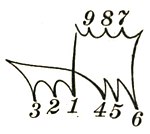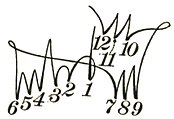24
ESSENTIALS IN CONDUCTING
 SLOW FOUR-BEAT MEASURE |
 SLOW NINE-BEAT MEASURE | |
 SLOW TWELVE-BEAT MEASURE | ||
An examination of these figures will show that all baton movements are based upon four general principles:
- The strongest pulse of a measure (the first one) is always marked by a down-beat. This principle is merely a specific application of the general fact that a downward stroke is stronger than an upward one (cf. driving a nail).
- The last pulse of a measure is always marked by an up-beat, since it is generally the weakest part of the measure.
- In three- and four-beat measures, the beats are so planned that there is never any danger of the hands colliding in conducting vigorous movements that call for the use of the free hand as well as the one holding the baton.
- In compound measures the secondary accent is marked by a beat almost as strong as that given the primary accent.
NUMBER OF BEATS DETERMINED BY TEMPOThe fact that a composition is in 4–4 measure does not necessarily mean that every measure is to be directed by being given four actual beats, and one of the things that the conductor must learn is when to give more beats and when fewer.
If the tempo is very rapid, the 4–4 measure will